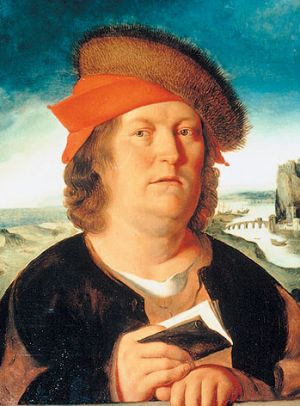
Retrato de Paracelso "médico integral".
Quién fue Paracelso?
Philippus Aureolus Theophrastus Paracelsus Bombastus von Hohenheim, “Paracelso” nació el 17 de diciembre de 1493 en Einsiedeln, Suiza. Falleció el 24 de septiembre de 1541.
Su lápida lo recuerda así: "Aquí yace Felipe Teofrasto Bombast von Hohenheim. Famoso doctor en Medicina que curó toda clase de heridas; la lepra, la gota, la hidropesía y otras varias enfermedades del cuerpo, con ciencia maravillosa". Fue el iniciador de la química farmacológica y se adelantó en la marcha de la medicina hacia las ciencias naturales. La continuidad histórica se va a establecer en el siglo XVII con una nueva corriente: la iatroquímica. Se anticipó a todos en la experimentación de vacunas, la descripción de la pneumoconiosis, el descubrimiento de la relación entre cretinismo y bocio y el empleo del hierro y otras substancias inorgánicas en la terapéutica; además, introdujo la noción de enfermedades metabólicas con la idea de enfermeades tartáricas, en que el tártaro, el veneno, aparecía depositado en los órganos, y la idea de substancias químicas como fármacos específicos. Creador de la palabra espagiria: "separar para volver a reunir de una forma nueva" y desarrolló a través de ella: sales, elixires, tinturas, piedras vegetales y otros preparados que apuntan a la sanación en forma holística. Sus remedios nunca operaron solamente sobre los síntomas corpóreos de la enfermedad, sino también sobre las causas espirituales de las enfermedades.
Su padre era médico. Junto a los bosques, montes y ríos de su ciudad natal y a los hombres rudos de ese país, su padre le enseñó las primeras letras y le hizo conocer y admirar la naturaleza. Desde niño acompañó a su padre en las visitas a enfermos. A los 6 años de edad murió su madre. Tenía 8 años cuando se trasladaron a los Alpes austríacos, a Villach, junto a una abadía de los benedictinos. Allí tuvo contacto con otros hombres, también rudos, los mineros, y conoció las minas y los hornos y el arte de separación de elementos químicos. Recibió su primera educación de los monjes del monasterio. Su primer maestro fue su padre, quedando así una vez más demostrado que más se aprende con el ejemplo que con el precepto, lo instruyó en latín, botánica y cirugía. En su juventud lo envían al monasterio de los benedictinos de San Andrés en Levanthal y allí se conoce con el obispo Eberhard Baumgartener gran alquimista. Luego pasa a Basilea donde continúa con los estudios y allí es cuando reconoce que es imposible dedicarse a la medicina sin saber astrología...
Primero estudió las artes liberales (trivium: gramática, retórica, dialéctica, cuadrivium: geometría, aritmética, música y astronomía) probablemente en Viena, para luego ser médico, y, con ese fin, se fue a Ferrara, en Italia. Allí al parecer se tituló de doctor, y siguiendo la costumbre de la época, latinizó su nombre y eligió el de Paracelsus. Ya en el momento de titularse, a los 23 años, sentía tener experiencia, había crecido observando la naturaleza y, junto a su padre, también a los enfermos. Convencido de que el arte de sanar había que buscarlo en la naturaleza y no en los libros y de que había que salir y recorrer el mundo para conocer las enfermedades y las medicinas naturales que usaban los campesinos, los artesanos, los barberos y las mujeres del pueblo. Entonces inició su largo viaje por Europa, en que llegó hasta Moscú, de allí, descendiendo a través de Kiev por los Balcanes, llegó al Asia Menor y a Egipto, desde donde regresó a Villach pasando por Italia. Su peregrinación duró 12 años. Muchos jóvenes lo siguieron en estas andanzas. Dijo entonces: Comadronas, curanderos, nigromantes, barberos, pastores y campesinos saben muchas cosas que aparentemente no han sido tomadas en consideración por los doctores eruditos. Los barberos, los médicos del pueblo, saben el arte de curar, no a merced de los libros sino a través de la luz de la naturaleza o por la tradición procedente de los antiguos magos.
Se caracterizó por poseer una sabiduría multidisciplinaria propia de los genios. Sus trabajos conjugarían la alquimia, la espagiria y las ciencis sagradas, con las raíces milenarias de la medicina clásica griega y arabe con sustento en el conocimiento egipcio. Tenía poco más de 30 años. Entonces, habiendo arrojado su gorra de doctor y habiéndola cambiado por un sombrero blando, escribió su primera obra, Paramirum, pero no lo hizo en latín sino en alemán. Es una obra de juventud, una obra esquemática en que analiza las causas generales de las enfermedades. Cinco esferas o entia determinan la vida humana:
Ens astrale, ens veneni, ens naturale, ens spirituale, ens Dei.
Ens astrale, pues toda persona nace en el momento de una constelación y es hijo de su tiempo.
Ens veneni, pues el hombre es parte de la naturaleza, está expuesto a sufrir la acción de las cosas que toma del mundo circundante.
Ens naturale trata del camino que recorre el hombre desde su nacimiento hasta la muerte, camino determinado por su constitución y destino.
Ens spirituale, pues el hombre tiene cuerpo y espíritu, y por el espíritu el mundo circundante se convierte para cada individuo en un mundo distinto y el hombre se hace pensador y creador. La enfermedad viene de la alteración del orden de estas cuatro esferas, la curación está determinada por la quinta:
Ens Dei.
En esta primera obra se ve ya al Paracelso místico y astrólogo. Es un intento de antropología médica.
Después de una corta estadía en Villach, se fue a Salzburgo y luego a Estrasburgo. Pero aunque Estrasburgo parecía una ciudad ideal para vivir en la quietud tras haber recorrido el mundo y acumulado tanta experiencia, un hecho ocurrido en 1526 lo hizo trasladarse a la vecina Basilea. Había enfermado el famoso impresor Frobenius, junto al cual vivía Erasmo de Rotterdam. Los médicos le habían diagnosticado una gangrena del pie a Frobenius y habían aconsejado la amputación. Y Erasmo, que había oído hablar de ese extraño médico y de sus curas asombrosas, aconsejó mandarlo a buscar. Así llegó Paracelso a Basilea y curó a Frobenius. El ayuntamiento de la ciudad ofreció a Paracelso la vacante de médico municipal, con licencia para dar clases en la Universidad. Se había cumplido el gran deseo de Paracelso de poder transmitir su experiencia.
Pero no alcanzó a durar un año, el de 1527, en Basilea, pues empezó publicando un programa revolucionario, que decía así: "No vamos a seguir las enseñanzas de los viejos maestros, sino la observación de la naturaleza, confirmada por una larga práctica y experiencia. ¿Quién ignora que la mayor parte de los médicos dan falsos pasos en perjuicio de sus enfermos? Y esto sólo por atenerse a las palabras de Hipócrates, Galeno, Avicena y otros. Lo que el médico necesita es el conocimiento de la naturaleza y de sus secretos. Yo comentaré, por lo tanto, cuotidianamente, durante dos horas en público y con gran diligencia para provecho de mi auditorio, el contenido de los libros de medicina interna y cirugía práctica y teórica, de los cuales yo mismo soy autor. No he escrito estos libros como muchas otras personas repitiendo lo que han dicho Hipócrates o Galeno, sino que los he creado basándome en mi experiencia, que es la máxima maestra de todas las cosas. Y lo demostraré, no con las palabras de las autoridades, sino mediante experimentos y consideraciones razonables. Si vosotros, queridos lectores míos, sentís el afán de entrar en estos secretos divinos, si alguno quiere aprender en breve tiempo toda la medicina, que venga a Basilea a visitarme y encontrará todavía más de lo que puedo decir con palabras. Para explicarme con mayor claridad indicaré, como ejemplo, que no creo en el dogma de los humores con el que los antiguos explican equivocadamente todas las enfermedades; pues únicamente una mínima parte de los médicos de hoy tiene un conocimiento más exacto de las enfermedades, de sus causas y de sus días críticos. Prohibo hacer juicios superficiales sobre Teofrasto antes de haberlo oído. Que Dios os guarde y os haga comprender benévolamente la reforma de la medicina. Basilea, día 5 de junio de 1527.
Paracelso nunca vio a sus pacientes como simples números, los atendió en sanación del cuerpo, el alma y el espíritu en su conjunto. No fue en contra de las ciencais sagradas, aprovechó sus raíces al máximo. Conjugó el poder de las influencias de los astros, las formas, las sustancias y sus signaturas planetarias con un arte ejemplar. Fue expulsado de la ciudad de Basilea, fruto de una campaña de desprestigio, mantenida por el resto de los médicos, de tendencias conservadoras y materialistas. Esta campaña contra Paracelso se debió a que no reconocía ninguna otra autoridad médica por encima de él que no fuera la naturaleza, obteniendo favorables resultados en sus tratamientos, situación esta que desesperaba a la clase médica de entonces. La cosmología de Paracelso es por demás vasta: con plena raíz cristiana bajo el poder del Espíritu Santo, obró acelerando los procesos de la madre naturaleza. Hizo una verdadera ciencia con conciencia como es la alquimia en todos sus estadios.
Paracelso fue tachado de hereje de la misma manera que los gnósticos, y sus enemigos le definían como vagabundo, pero él sólo seguía las pautas de la naturaleza. Al mismo tiempo aplico la enseñanza que por medio de la alquimia le era revelada. Como dice en su Fragmenta medica,” el objeto de la alquimia no es transformar metales innobles en plata u oro, sino crear un remedio contra todas las enfermedades.” Se dice que Paracelso aprendió el arte de la alquimia durante uno de sus viajes a Constantinopla, de boca de Salomón Trismosin.
Según Paracelso, la naturaleza muestra el proceso de la curación. El médico es sólo un instrumento, su tarea consiste en descubrir las relaciones ocultas, coordinar una parte con otra. "Tan pronto como el hombre llega al conocimiento de sí mismo, no necesita ya ninguna ayuda ajena."
Paracelso concibió al cosmos como un organismo, y al hombre, como un microcosmos, ambos formados por las mismas substancias químicas. Asufre, mercurio y sal son para él las substancias esenciales del organismo, cuya proporción mantiene o modifica el archeus, principio vital. Paracelso quería la unión del alma y el espíritu divino, para concebir el funcionamiento del Espíritu Universal dentro de la Naturaleza. En sus escritos se lee: “la Magia es sabiduría, es el empleo consciente de las fuerzas espirituales, para la obtención de fenómenos visibles, o tangibles, reales o ilusorios, es el uso bienhechor del poder de la voluntad, del amor y de la imaginación; es la fuerza mas poderosa del espíritu humano empleada en el bien. La Magia no es brujería.”
Paracelso hablaba abiertamente de los cuatros reinos de la naturaleza como: Fuego, Aire, Agua y Tierra como lo hacían los antiguos. En su laboratorio no faltaban los artilugios propios de un gran alquimista, como crisoles, balanzas, alambiques, fuelles, etc. Del macrocosmos y microcosmos hombre decía: “un médico antes de extender una receta debe mirar el cielo” “No se puede comprender al hombre, sino por medio del cielo, pues somos hijos del cielo”. “la fe es una estrella luminosa que guía al investigador a través de los secretos de la Naturaleza. Es necesario buscar vuestro punto de apoyo en Dios”.
Veamos como definía a un verdadero médico: "Aquel que puede curar enfermedades es médico. Ni los emperadores, ni los papas, ni los colegas, ni las escuelas superiores pueden crear médicos. Pueden conferir privilegios y hacer que una persona que no es médico, aparezca como si lo fuera pueden darle permiso para matar, pero no pueden darle el poder de sanar; no pueden hacerle médico verdadero si no ha sido ya ordenado por Dios. El verdadero médico no se jacta de su habilidad ni alaba sus medicinas, ni procura monopolizar el derecho de explotar al enfermo, pues sabe que la obra ha de alabar al maestro y no el maestro a la obra. Hay un conocimiento que deriva del hombre y otro que deriva de Dios por medio de la luz de la Naturaleza. El que no ha nacido para médico, nunca lo será. El médico debe ser leal y caritativo. El egoísta muy poco hará en favor de sus enfermos. Conocer las experiencias de los demás es muy útil para un médico, pero toda la ciencia de los libros no basta para hacer médico a un hombre, a menos que lo sea ya por naturaleza. Sólo Dios da la sabiduría médica".
El hombre es triple: pertenece al mundo visible por su cuerpo físico, al mundo sideral por su cuerpo astral, y al mundo espiritual por su Alma inmortal o Mens. El Alma humana (no condicionada por las imperfecciones y defectos psicológicos) posee en sí todas las ciencias en estado latente. Quien se conoce a sí mismo, conoce implícitamente a Dios. Para él el universo es un perpetuo flujo y reflujo de vida, que pasa por el hombre para ir de Dios a las cosas y de las cosas a Dios.
Paracelso se muestra fiel a la ortodoxia alquímica, con los tres principios (sal, azufre y mercurio) y los cuatro elementos, si bien esta teoría la desarrolló más ampliamente para provecho de las siguientes generaciones. Según él, a partir del Yliaster, primera materia, surgen dos principios: uno negativo, femenino y pasivo; otro positivo, masculino y activo. Del encuentro de ambos surge el Caos, el Hyle, la materia primitiva que es el génesis de todo lo creado. Gracias a la luz, surgen de allí los cuatro elementos, y a partir de ese momento los diferentes seres que pueblan el universo. Sus trabajos son materia de estudio hasta el presente, ya que muchos de ellos fueron escritos en códigos de palabras propios de los alquimistas revelados, donde es necesario poseer cierto conocimiento y guía de Dios para llegar a buen puerto.
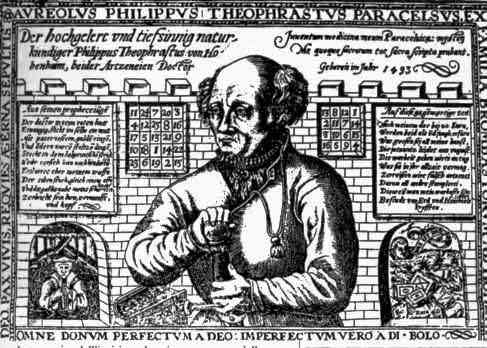
Las Siete Reglas de Paracelso
1º Lo primero es mejorar la salud. Para ello hay que respirar con la mayor frecuencia posible, honda y rítmica, llenando bien los pulmones, al aire libre o asomado a una ventana. Beber diariamente en pequeños sorbos, comer muchas frutas, masticar los alimentos del modo más perfecto posible, evitar el alcohol, el tabaco y las medicinas, a menos que estuvieras por alguna causa grave sometido a un tratamiento. Bañarte diariamente, es un habito que debes a tu propia dignidad.
2º Desterrar absolutamente de tu ánimo, por más motivos que existan, toda idea de pesimismo, rencor, odio, tedio, tristeza, venganza y pobreza.
Huir como de la peste de toda ocasión de tratar a personas maldicientes, viciosas, ruines, murmuradoras, indolentes, chismosas, vanidosas o vulgares e inferiores por natural bajeza de entendimiento o por tópicos sensualistas que forman la base de sus discursos u ocupaciones. La observancia de esta regla es de importancia decisiva: se trata de cambiar la espiritual contextura de tu alma. Es el único medio de cambiar tu destino, pues este depende de nuestros actos y pensamientos. El azar no existe.
3º Haz todo el bien posible. Auxilia a todo desgraciado siempre que puedas, pero jamás tengas debilidades por ninguna persona. Debes cuidar tus propias energías y huir de todo sentimentalismo.
4º Hay que olvidar toda ofensa, mas aún: esfuérzate por pensar bien del mayor enemigo. Tu alma es un templo que no debe ser jamás profanado por el odio. Todos los grandes seres se han dejado guiar por esa suave voz interior, pero no te hablara así de pronto, tienes que prepararte por un tiempo; destruir las superpuestas capas de viejos hábitos, pensamientos y errores que pesan sobre tu espíritu, que es divino y perfecto en si, pero impotente por lo imperfecto del vehículo que le ofreces hoy para manifestarse, la carne flaca.
5º Debes recogerte todos los días en donde nadie pueda turbarte, siquiera por media hora, sentarte lo más cómodamente posible con los ojos medio entornados y no pensar en nada. Esto fortifica enérgicamente el cerebro y el Espíritu y te pondrá en contacto con las buenas influencias. En este estado de recogimiento y silencio, suelen ocurrírsenos a veces luminosas ideas, susceptibles de cambiar toda una existencia. Con el tiempo todos los problemas que se presentan serán resueltos victoriosamente por una voz interior que te guiara en tales instantes de silencio, a solas con tu conciencia. Ese es el daimon de que habla Sócrates.
6º Debes guardar absoluto silencio de todos tus asuntos personales. Abstenerse, como si hubieras hecho juramento solemne, de referir a los demás, aun de tus más íntimos todo cuanto pienses, oigas, sepas, aprendas, sospeches o descubras. por un largo tiempo al menos debes ser como casa tapiada o jardín sellado. Es regla de suma importancia.
7º Jamás temas a los hombres ni te inspire sobresalto el día de mañana.
Ten tu alma fuerte y limpia y todo te saldrá bien.
Jamás te creas solo ni débil, porque hay detrás de ti ejércitos poderosos, que no concibes ni en sueños.
Si elevas tu espíritu no habrá mal que pueda tocarte.
El único enemigo a quien debes temer es a ti mismo.
El miedo y desconfianza en el futuro son madres funestas de todos los fracasos, atraen las malas influencias y con ellas el desastre.
Si estudias atentamente a las personas de buena suerte, veras que intuitivamente, observan gran parte de las reglas que anteceden. Muchas de las que allegan gran riqueza, muy cierto es que no son del todo buenas personas, en el sentido recto, pero poseen muchas virtudes que arriba se mencionan. Por otra parte, la riqueza no es sinónimo de dicha; Puede ser uno de los factores que a ella conduce, por el poder que nos da para ejercer grandes y nobles obras; pero la dicha más duradera solo se consigue por otros caminos; allí donde nunca impera el antiguo Satán de la leyenda, cuyo verdadero nombre es el egoísmo. Jamás te quejes de nada, domina tus sentidos; huye tanto de la humildad como de la vanidad. La humildad te sustraerá fuerzas y la vanidad es tan nociva, que es como si dijéramos: pecado mortal contra el Espíritu Santo.
----
apuntes sobre símbolos alquímicos
La alquimia, muy relacionada con el Hermetismo (doctrina filosófica y
religiosa en torno a la figura de Hermes Trimegisto), se desarrolló
durante la Edad Media en Europa y buscaba principalmente entender la
naturaleza y convertir minerales inferiores (metal vil) en oro o plata;
aunque va mucho más allá, ya que esta búsqueda es símbolo de
transformación de algo impuro a algo valioso, el paso de la ignorancia a
la sabiduría, la iluminación.
La creación de un sistema tan complejo de símbolos como es el alquímico,
se debe en gran parte al temor a las persecuciones, por lo que este
conocimiento se llevó a cabo con secretismo (lo que desembocó en la
desacreditación de algunos de sus hallazgos científicos)
Las tres bases alquímicas:
Hay dos sustancias opuestas, el Azufre y el Mercurio. La Sal o Arsénico es el término medio, un nexo de unión entre ellas. El Azufre (masculino, caliente, fijo, activo) es la forma y el Mercurio (femenino, frío, volátil, pasivo), la materia. La Sal es el movimiento.
El símbolo del Mercurio también representa la fluidez, la unión de lo
material y lo espiritual, el paso del metal al oro. El símbolo del
Azufre representa la sequedad, la fuerza, el deseo de alcanzar un estado
superior. El Azufre y el Mercurio van a estar estrechamente
relacionados con la clasificación de los cuatro elementos.
 |
| De izquierda a derecha: Azufre, Mercurio y Sal. |
Los cuatro elementos: Tierra (femenino, aspectos fríos y secos, se asocia al cobre y es símbolo de nacimiento y creación), Agua (femenino, fase fría, y seca del proceso alquímico, asociado al estaño y símbolo de purificación), Aire (masculino, fases cálidas y húmedas del proceso, asociado al hierro y símbolo de la vida) y Fuego (masculino, aspectos cálidos y secos, asociado al plomo y símbolo de la transformación final).
 |
| Los cuatro elementos |
 |
| Esquema de las alteraciones continuas entre los distintos elementos. |
La piedra filosofal
El triángulo son las tres sustancias
celestiales; el cuadrado representa los cuatro elementos y el círculo
simboliza la unidad, el todo.
Los siete metales planetarios
Dos de estos siete metales son perfectos e inalterables: el Oro y la
Plata, simbolizados por el Sol y la Luna respectivamente. El Oro es el
fin de la búsqueda, la perfección metálica. De este modo, podemos
establecer una jerarquía de metales, siendo el Oro la perfección,
seguido por la Plata, el Mercurio, el Estaño (simbolizado por
Júpiter), el Plomo (simbolizado por Saturno), el Cobre (Venus) y el
Hierro (Marte).
Animales
Los animales tienen su simbolismo propio. El Águila simboliza el
Aire, el Mercurio; el León, la Tierra, el Azufre; el Pez, el Agua, el
Azufre y el Dragón, el Fuego, el Mercurio.
El Fénix simboliza el final del proceso alquímico: la consecución del oro y la perfección filosófica.
El Uróboros o Ouroboros (serpiente que se muerde la cola)
representa la inmortalidad y la continuidad. También simboliza que "todo
es uno", el principio alquímico.
El Caduceo representa la unión de los contrarios, la transformación y el equilibrio al que se llega en el proceso.
El León verde representa al vitriolo verde, un líquido utilizado
con frecuencia por los alquimistas, muy corrosivo.Suele representarse
devorando al Sol.
El Águila también representa la transformación del metal vil en oro, el final de lo impuro y el surgimiento de lo puro.
Sello de Salomón - Hexagrama
El Sello de Salomón es una estrella de seis puntas, por lo que tiene su
origen en el judaísmo (Estrella de David) Combina los símbolos de los
elementos, por lo que significa equilibrio, unión de opuestos,
metamorfosis.
Si os ha parecido interesante, no dudéis en recurrir a mejores y más
amplias fuentes; como he dicho, esto es sólo un brevísimo apunte.





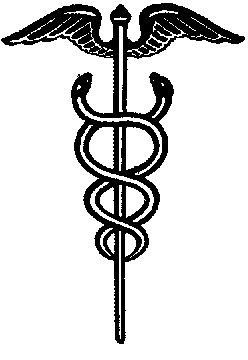


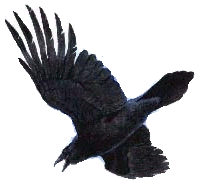


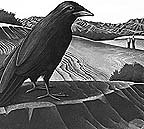


 The Teachings of Don Juan (1968):
The Teachings of Don Juan (1968):
 A Separate Reality (1971):
A Separate Reality (1971):
 Journey To Ixtlan (1972):
Journey To Ixtlan (1972):
 The Active Side of Infinity (1998):
The Active Side of Infinity (1998):




